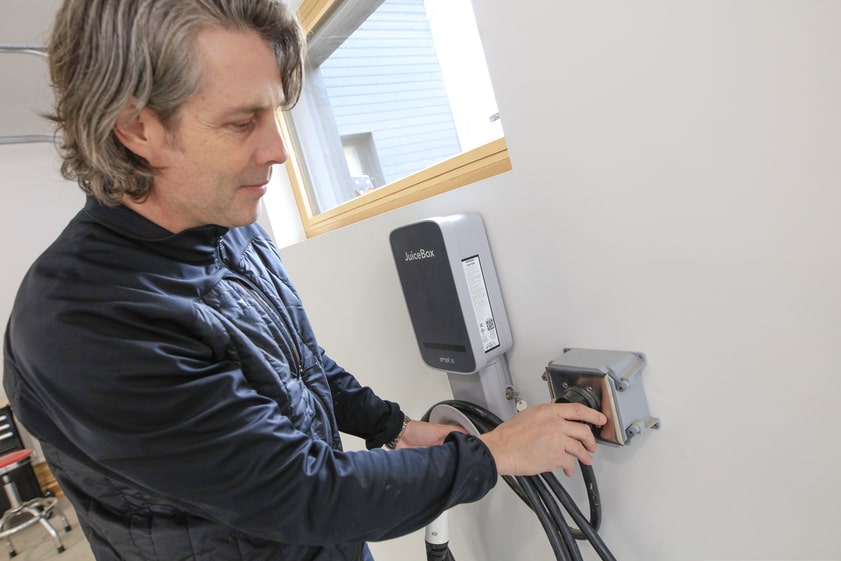Home EV Charging: How to know which plug type is right for you

Purchased an electric vehicle (EV) or plan to soon? If so, you may have already begun your research into a home EV charger like Enel X’s JuiceBox. Throughout this process, you may have come across different plug types, such as the NEMA 14-50 and NEMA 6-50 plug. And now, you may wonder what plug options exist and which type is the best choice. If this situation sounds familiar, read on to understand the difference between plug types and how to know which option is right for you.
Get to Know Your Outlet
First, let’s note the difference between the plug and the EV charging connector. The plug connects into your outlet in the wall, while the EV charging connector plugs into your vehicle.
Throughout North America, most homes are outfitted with standard 120-volt electricity outlets. While many other countries use a 220 or 230-volt system, the U.S. still relies on the relatively weak 120-volt system. Why? To make a long story short, the US electrical system predates the rest of the world. In the late 19th century, Thomas Edison instituted a relatively low voltage to promote safety and widespread consumer adoption. The strategy worked. Millions of American homeowners purchased appliances and lighting designed to utilize the lower voltage. When using most appliances, we don’t notice the difference. But when charging electric vehicles, a higher voltage is preferable.
While it’s possible to plug an EV directly into the wall via a standard 120-volt outlet, it’s not the ideal option. This is called Level 1 or “trickle-charging,” which is a good name for it considering that you’ll only add about three or four miles of range for every hour plugged into a standard outlet. With the ample size of today’s 200-plus mile electric cars, it could take more than 24 hours to go from empty to full using a standard outlet. That’s why companies like Enel X offer home EV charging station options like the JuiceBox 40, which can charge an EV battery from empty to full in just a few hours.
Plugging In Your Home EV Charger
A home EV charger is the interface between the electricity flowing through your house and an electric vehicle’s battery management and charging system. It needs to be either hardwired or plugged in using a heavy-duty outlet—similar to those used for clothes dryers or ovens. 240 volts is the Goldilocks-sized sweet spot for an EV’s electric supply. Amperage, the unit of measure for current, is also important. Today'/ca/en/s most common plug-in home EV charging setup uses a 50 amp, 240-volt outlet to safely allow for a 40 amp Level 2 charger, since electrical standards require a circuit to be equal to 125% of a device'/ca/en/s continuous load. This setup effectively charges at 10 kilowatts -- which is the total power you get when you multiply the current (40 amps) by the voltage (240 volts) – and nicely suits the amount of power today’s electric cars commonly accept.
Choosing the right plug type for you
There are two main plug types commonly used for home EV charging, both standardized and rated by NEMA, the largest trade association of electrical equipment manufacturers in the US.
1. NEMA 14-50 Plug
The “50” in the name stands for the 50-amp maximum amperage, which is needed for a 40 amp home charging station for the safety reasons described above. A NEMA 14-50 plug has two "hots," a ground, and a neutral. Typically, NEMA 14-50 is the recommended 50- amp plug, as it is the most versatile option.
2. NEMA 6-50 Plug
As with the 14-50, 50 is also the maximum amperage for the NEMA 6-50 plug. The difference between the 14-50 and 6-50 is that the 6-50 has no neutral -- it only has the two "hots" and the ground. The 6-50 may be marginally cheaper and easier to install, as the neutral wire is an added cost and the power cord is smaller and more flexible.
Note that dryer plugs, which are often NEMA 14-30s and 10-30s, are only compatible with 30 amp outlets. One of these outlets can only provide about 6 kilowatts—not enough amperage to attain the charging times that products like JuiceBox 40 can reach, although you can use the app to reduce your JuiceBox’s power.
If you need more power than 50 amps—for example, for a high-performance EV with an onboard 11-kW charger, then you’ll need to buy a JuiceBox 48. For this ultra-powerful EV charger, you’ll need to skip the outlet altogether and have an electrician hardwire the device directly to the circuit. The permanent hardwiring of the JuiceBox 48 is required for safety reasons. A licensed electrician will wire the device directly to the circuit—without the ability to plug and unplug the EV charging station.
The Bottom Line
When it comes down to it, plug type has little impact on your EV charging experience. Both are safe, modern, and powerful plugs that will enable you to charge your EV at home much faster than with a standard 120-volt outlet. If you drive a high-performance electric vehicle like a Tesla, you may be better off hardwiring your device instead of plugging it in. Consult with a qualified electrician to confirm that your home’s electrical supply is adequate for charging an EV using a NEMA 14-50 or 6-50 plug. Whether you are searching for a Tesla, Audi, Chevrolet Bolt or Nissan LEAF charger, don’t hesitate to ask us. Our experts are always ready to help you.



